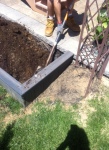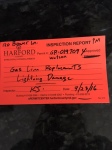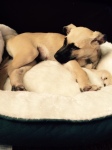The Valley of the Voles, the soap opera of the garden, if you will. A frivolous post, but next week I will return with an interview by author T. Eric Bakutis.
For Mother’s Day two years ago my husband bought me this lovely arch for our patio. We planted clematis and the plants — white and purple flowers — grew in beauty and stature. It was everything I ever wanted.

Last year, for Mother’s Day, my husband built a planter to the right of the arch. We put in roses of sharon and hyacinth and talked about strawberry plants. In building the planter, my husband made the planter level with the existing patio, joining on the bottom with the mulch in the bed that creeps around the west side. There was a slight gap between the bottom of the planter and the ground. In little beastie language this means “Come on in” or “Open door policy” as translated by my friend Nancy. Against all intention, we’d designed an attractive rodent condominium. The renters came.
I thought we had a mole. Instead, we had voles.
Mole: A solitary animal that digs tunnels in your yard and eats grubs.
Vole: A rodent cousin to a mouse. 155 different species. They have litter after litter. If you have an outside cat, you might have been gifted a dead one.
They run paths through your grass until they reach bare dirt. From above, it looks like a labyrinth extending through your yard. I caught my first glimpses of dark gray skittering down the trails, the trails that ended/began at one corner of the planter, but I wasn’t ANGRY. Live and let live.
Then they ate my clematis. The green shoots above ground were chomped off. I dug up what was left.
Here is the root ball. You can see there were about 100 individual roots. Three were left.

The eaten clematis
After examination, I followed the underground tunnel back the planter and collapsed the tunnel, backfilling with my gloved hands. I replanted the clematis.
By now I’d seen at least two voles. They liked to do their morning labyrinth run at the same time I came down to check my hyacinths after putting kids on the bus. One was gray and slinky and the other was fat and brown like a gerbil. They appeared to be friends. Maybe more than friends, if the gerbil was pregnant.
I read up about voles. How, if you don’t have a dog or cat, you can buy fox, coyote, or dog urine on Ebay and hunting websites. Huh. What’s to stop someone from peeing into a container and selling it as ‘predator urine.’ Seriously. And how was I supposed to spread it around. No. This was not a feasible plan. I was, however, willing to give my neighbor’s dog a lot of water to drink and let her run around my yard. Conclusion: No discernable vole exodus.
But, at least my hyacinths were blooming. Three purple flowers of miniature bells all in a row, strong and fecund in their second year of blooming.
And then this.

They dragged it down into their hidden lair.
Not okay, voles. This is NOT OKAY. Again, I dug up their tunnel, tracing the litter of hyacinth bells and little bits of green. They’d pulled the whole thing down, leaving only that one green leave behind.
The next day the second hyacinth was pulled down into a hole. Not even a leaf left behind.
My husband stepped in. “This is enough,” he said. He brought home mouse traps, baited them with peanut butter, but the ants ate it all up.
He pulled up the third, and last, hyacinth. The tunnel was evident underneath. They’d been working on it. I imagined the little rodents in prison white and black stripes. Maybe taking turns, one popping up for a smoke break, before tunneling again. We put the hyacinth leaves in a mouse trap and laid it across their labyrinth paths. The trap sprung, but didn’t catch anything.
My husband went shopping again. He came home with two things: mouse poison and CLEMATIS LEAVES.
The voles had misinterpreted my tunnel collapsing behavior. I was saying, “Move on.” They thought I meant move to the other corner of the planter. New trails appeared in the grass on that end.
My husband and I set the clematis leaves in the traps. We caught a vole. We set out the poison near the gap. It was nibbled.
We set out another trap with clematis leaves.

Leaves plucked from somone else’s clematis plant and kept on ice because that’s how our voles like it.
In the morning, I saw a vole wandering in circles. My husband shoveled it. I did not take a picture. Two gray voles dead, but nothing doing with the fat brown one. I’d started calling him/her Gus. Worried that Gus couldn’t get to the poison (it was inside a plastic container), my husband removed the top. More poison nibbled.
Then, in checking the mousetrap, we found it deconstructed all over the lawn. Our guess is that a vole (Gus?) was caught in trap and a hawk flew down and picked up the whole thing, then dropped it and it flew into pieces across the yard.
Finally the traps sat there with shriveled clematis leaves. No more poison nibbled. We threw away the traps and the poison. Last weekend — Mother’s Day — we dug up the mulch and top layer of soil, dumping it on a tarp. Didn’t see any voles. Didn’t find any lair. We mixed around the soil, took out the end plants, put the end plants back in, put the top layer and then the mulch back on. We planted grape vines on either side of the arch. Voles are not supposed to like grapes vines.

Digging up the vole tunnels, looking for the hidden lair (which we never found)

Clematis transplanted to front yard, hopefully to climb up the lamp post on the right and cover with flowers.
If I had been faster to post this, that would be the end of the saga about voles. But, after Mother’s Day I went down to the patio. Laying at the bottom of the stairs with no visible wounds? A dead vole.


























